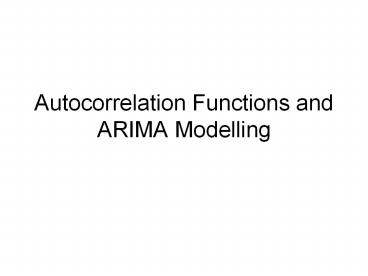Autocorrelation Functions and ARIMA Modelling PowerPoint PPT Presentation
Title: Autocorrelation Functions and ARIMA Modelling
1
Autocorrelation Functions and ARIMA Modelling
2
Introduction
- Define what stationarity is and why it is so
important to Econometrics - Describe the Autocorrelation coefficient and its
relationship to stationarity - Evaluate the Q-statistic
- Describe the components of an Autoregressive
Integrated Moving Average Model (ARIMA model)
3
Stationarity
- A strictly stationary process is one where the
distribution of its values remains the same as
time proceeds, implying that the probability lies
in a particular interval is the same now as at
any point in the past or the future. - However we tend to use the criteria relating to a
weakly stationary process to determine if a
series is stationary or not.
4
Weakly Stationary Series
- A stationary process or series has the following
properties - - constant mean
- - constant variance
- - constant autocovariance structure
- The latter refers to the covariance between
y(t-1) and y(t-2) being the same as y(t-5) and
y(t-6).
5
Stationary Series
6
Stationary Series
7
Non-stationary Series
8
Implications of Non-stationary data
- If the variables in an OLS regression are not
stationary, they tend to produce regressions with
high R-squared statistics and low DW statistics,
indicating high levels of autocorrelation. - This is caused by the drift in the variables
often being related, but not directly accounted
for in the regression, hence the omitted variable
effect.
9
Stationary Data
- It is important to determine if our data is
stationary before the regression. This can be
done in a number of ways - - plotting the data
- - assessing the autocorrelation function
- - Using a specific test on the significance of
the autocorrelation coefficients. - - Specific tests to be covered later.
10
Autocorrelation Function (ACF)
11
Correlogram
- The sample correlogram is the plot of the ACF
against k. - As the ACF lies between -1 and 1, the
correlogram also lies between these values. - It can be used to determine stationarity, if the
ACF falls immediately from 1 to 0, then equals
about 0 thereafter, the series is stationary. - If the ACF declines gradually from 1 to 0 over a
prolonged period of time, then it is not
stationary.
12
Stationary time series
13
Statistical Significance of the ACF
- The Q statistic can be used to determine if the
sample ACFs are jointly equal to zero. - If jointly equal to zero we can conclude that the
series is stationary. - It follows the chi-squared distribution, where
the null hypothesis is that the sample ACFs
jointly equal zero.
14
Q statistic
15
Ljung-Box Statistic
- This statistic is the same as the Q statistic in
large samples, but has better properties in small
samples.
16
Partial ACF
- The Partial Autocorrelation Function (PACF) is
similar to the ACF, however it measures
correlation between observations that are k time
periods apart, after controlling for correlations
at intermediate lags. - This can also be used to produce a partial
correlogram, which is used in Box-Jenkins
methodology (covered later).
17
Q-statistic Example
- The following information, from a specific
variable can be used to determine if a time
series is stationary or not.
18
Q-statistic
19
Autoregressive Process
- An AR process involves the inclusion of lagged
dependent variables. - An AR(1) process involves a single lag, an AR(p)
model involves p lags. - AR(1) processes are often referred to as the
random walk, or driftless random walk if we
exclude the constant.
20
AR Process
21
Moving Average (MA) process
- In this simple model, the dependent variable is
regressed against lagged values of the error
term. - We assume that the assumptions on the mean of the
error term being 0 and having a constant variance
etc still apply.
22
MA process
23
MA process
- To estimate moving average processes, involves
interpreting the coefficients and t-statistics in
the usual way - It is possible to have a model with lags on the
1st but not 2nd, then 3rd lags. This produces the
problem of how to determine the optimal number of
lags.
24
MA process
- The MA process has the following properties
relating to its mean and variance - -
25
Example of an MA Process
26
Example
- In the previous slide we have estimated a model
using an AR(1) process and MA(1) process or
ARMA(1,1) model, with a lag on the MA part to
pick up any inertia in adjustment in output. - The t-statistics are interpreted in the same way,
in this case only one MA lag was significant.
27
Conclusion
- Before conducting a regression, we need to
consider whether the variables are stationary or
not. - The ACF and correlogram is one way of determining
if a series is stationary, as is the Q-statistic - An AR(p) process involves the use of p lags of
the dependent variable as explanatory variables - A MA(q) process involves the use of q lags of the
error term.

